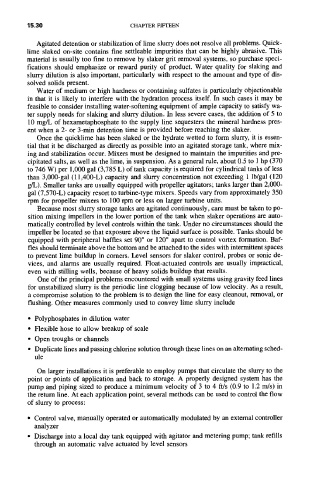Page 525 -
P. 525
15.30 CHAPTER FIFTEEN
Agitated detention or stabilization of lime slurry does not resolve all problems. Quick-
lime slaked on-site contains fine settleable impurities that can be highly abrasive. This
material is usually too fine to remove by slaker grit removal systems, so purchase speci-
fications should emphasize or reward purity of product. Water quality for slaking and
slurry dilution is also important, particularly with respect to the amount and type of dis-
solved solids present.
Water of medium or high hardness or containing sulfates is particularly objectionable
in that it is likely to interfere with the hydration process itself. In such cases it may be
feasible to consider installing water-softening equipment of ample capacity to satisfy wa-
ter supply needs for slaking and slurry dilution. In less severe cases, the addition of 5 to
10 mg/L of hexametaphosphate to the supply line sequesters the mineral hardness pres-
ent when a 2- or 3-min detention time is provided before reaching the slaker.
Once the quicklime has been slaked or the hydrate wetted to form slurry, it is essen-
tial that it be discharged as directly as possible into an agitated storage tank, where mix-
ing and stabilization occur. Mixers must be designed to maintain the impurities and pre-
cipitated salts, as well as the lime, in suspension. As a general rule, about 0.5 to 1 hp (370
to 746 W) per 1,000 gal (3,785 L) of tank capacity is required for cylindrical tanks of less
than 3,000-gal (11,400-L) capacity and slurry concentration not exceeding 1 lb/gal (120
g/L). Smaller tanks are usually equipped with propeller agitators; tanks larger than 2,000-
gal (7,570-L) capacity resort to turbine-type mixers. Speeds vary from approximately 350
rpm for propeller mixers to 100 rpm or less on larger turbine units.
Because most slurry storage tanks are agitated continuously, care must be taken to po-
sition mixing impellers in the lower portion of the tank when slaker operations are auto-
matically controlled by level controls within the tank. Under no circumstances should the
impeller be located so that exposure above the liquid surface is possible. Tanks should be
equipped with peripheral baffles set 90 ° or 120 ° apart to control vortex formation. Baf-
fles should terminate above the bottom and be attached to the sides with intermittent spaces
to prevent lime buildup in corners. Level sensors for slaker control, probes or sonic de-
vices, and alarms are usually required. Float-actuated controls are usually impractical,
even with stilling wells, because of heavy solids buildup that results.
One of the principal problems encountered with small systems using gravity feed lines
for unstabilized slurry is the periodic line clogging because of low velocity. As a result,
a compromise solution to the problem is to design the line for easy cleanout, removal, or
flushing. Other measures commonly used to convey lime slurry include
• Polyphosphates in dilution water
• Flexible hose to allow breakup of scale
• Open troughs or channels
• Duplicate lines and passing chlorine solution through these lines on an alternating sched-
ule
On larger installations it is preferable to employ pumps that circulate the slurry to the
point or points of application and back to storage. A properly designed system has the
pump and piping sized to produce a minimum velocity of 3 to 4 ft/s (0.9 to 1.2 m/s) in
the return line. At each application point, several methods can be used to control the flow
of slurry to process:
• Control valve, manually operated or automatically modulated by an external controller
analyzer
• Discharge into a local day tank equipped with agitator and metering pump; tank refills
through an automatic valve actuated by level sensors

